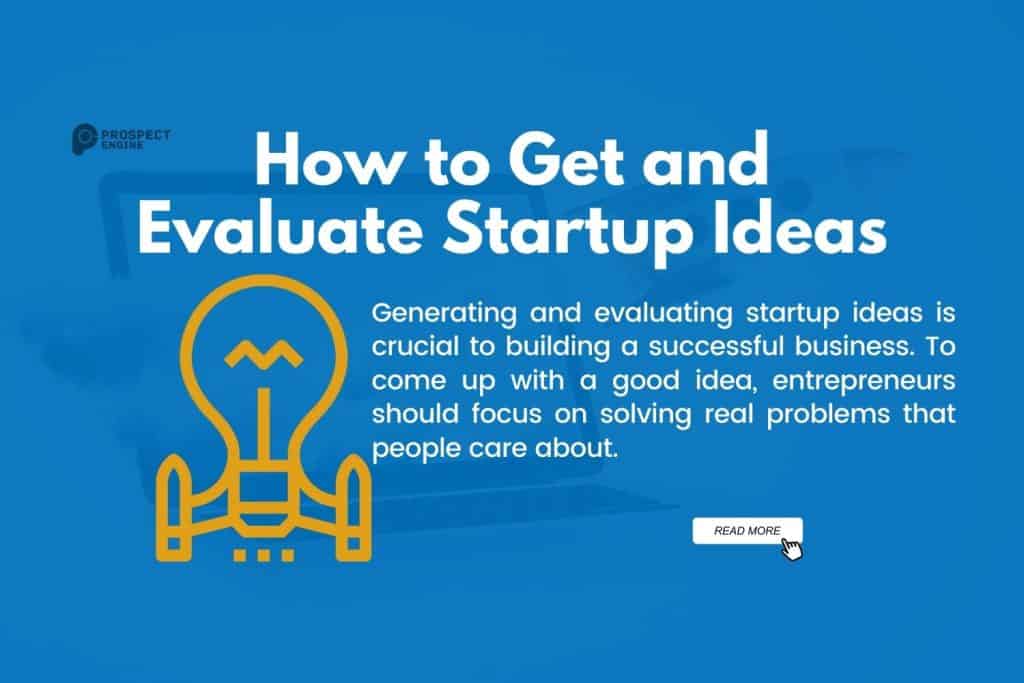If you’re interested in starting a new business, you may be wondering how to come up with a great idea that has the potential to be successful. This topic will explore different ways to generate startup ideas and evaluate their potential.
We’ll cover a range of methods, including market research, trend analysis, problem-solving, and brainstorming. You’ll learn how to identify customer pain points, assess market demand, and evaluate your competition.
We’ll also discuss how to test your idea with potential customers, gather feedback, and refine your concept. By the end of this topic, you should better understand the process of developing and evaluating startup ideas and be ready to take the next steps toward building your own successful business.
This Blog has three parts. First, I’ll discuss the founders’ most common mistakes with startup ideas. Then, I’ll discuss how to know if your idea is good and, finally, how to come up with new ideas.
Avoiding the Common Mistake of Building Solutions in Search of Problems
The most common mistake is building something that doesn’t solve a real problem for your users. You can articulate the problem you’re solving in words, but when you talk to users, it’s not something they care about. We call it a “solution in search of a problem” or a “crisp.”
For example, many founders developed an idea based on the thought process of “AI is cool. What could I apply AI to?” Then, they look for a problem they could solve with AI. That’s a solution in search of a problem, and it’s dangerous because if you do find a problem, it will likely be superficial and made up.
Falling in Love with the Right Problem: Avoiding Tar Pit Ideas in Entrepreneurship
As an entrepreneur, finding a problem to solve is the first step towards creating a successful startup. However, many founders make the mistake of focusing on issues people don’t care about. This can result in a lack of interest in their solution and, ultimately, failure.
To avoid this, falling in love with a problem is essential. This means identifying a high-quality problem that people care about, which can be solved with a startup. But be wary of tar pit ideas – common startup ideas that seem promising but have been around for years without success. These ideas are usually based on superficially plausible problems that are much harder to solve than they seem.
One example of a tar pit idea is the college student app for making plans with friends. While it seems like a common problem that could be easily solved, there are structural reasons why it’s hard to execute. In fact, no one has successfully created this app despite it being a popular idea for over 20 years.
How to Avoid Wasting Time and Energy on a Failed Startup Idea
To avoid wasting your time and energy on a tar pit idea, doing your research is crucial. Google your idea to see who else has worked on it in the past, and talk to those people to understand why it didn’t work. Identify the hard part of the problem and determine whether it can be solved in a scalable and profitable way.
Ultimately, the key to finding a successful startup idea is to focus on a specific, tractable problem that people care about. By falling in love with the problem, you’ll be motivated to find a solution that truly addresses your customers’ needs.
Finding the Sweet Spot
Starting a new company can be daunting, especially when it comes to finding the right idea to pursue. There’s no such thing as a perfect startup idea, but there is a sweet spot somewhere between picking the first idea that comes to mind and waiting for the perfect picture. This is the place where you want to be, and according to Paul Graham, it’s where you should think of your idea as a good starting point.
How do you know if your startup idea is good?
Here’s a framework of ten critical questions to ask about any startup idea:
- Do you have a founder market fit? This is probably the most important criterion for a successful startup. Are you and your team the right people to work on this idea? A great example of founder market fit is PlanGrid, which makes an iPad app to view construction blueprints. The founders of PlanGrid, Tracy, and Ralph, had worked in the construction industry and were the perfect team to build this product.
- How significant is the market? You need a big market, which typically means a billion-dollar market. But there are two kinds of demands for good startups: ones that are big now and ones that are small but rapidly growing. An example of the latter is Coinbase, which started in 2012 when the Bitcoin trading market was minuscule.
- How acute is the problem? The most common mistake is working on something that isn’t a problem or isn’t a problem people care enough about. A good example of an issue people care about is Brexit, which makes credit cards for startups. Before Brex, if a startup in NYC wanted a corporate credit card, they couldn’t get one because no bank would give a credit card to a startup.
- Do you have competition? Most founders think having a contest is bad, but counterintuitively, most good startup ideas have competition. However, if you’re going up against the especially entrenched competition, you typically need new insight.
- Do you want this personally? Do you know people personally who want it? It’s incredible how often people start companies where the answer to both these questions is no. If that’s the case, it’s time to talk to some users.
- Only recently became possible or necessary. Something that has recently changed in the world, like new technology, regulatory change, or a new problem, often creates a new opportunity. A great example of this is Checker, which does background checks via an API. It’s an API for doing background checks on people, and it’s a new opportunity that arose due to recent changes in the regulatory landscape.
- Can you make a compelling product? This question is straightforward. Can you make a product that people will love and that will solve the problem you’ve identified?
- Can you get customers? Building a great product is only half the battle. Can you get people to use it?
- How will you make money? This question is often overlooked, but figuring out how to make money is essential.
- What are the risks? Every startup has risks, and it’s important to identify them and figure out how you’ll mitigate them.
In the past few years, delivery services like DoorDash, Instacart, and Uber have grown significantly. To keep up with the demand, these companies needed to hire thousands of delivery people and run background checks on all of them. However, the existing companies that run background checks were not suited for this specific use case, creating a new market opportunity.
Using Proxy Companies to Identify Startup Opportunities
One way to identify such opportunities is to look at proxy companies. A proxy company does something similar to your startup but is not a direct competitor. For instance, when Rapid started its food delivery service in Latin America, it used DoorDash as a proxy to show that the idea of delivering food in Latin America would work.
The best startup ideas are often in dull spaces like tax accounting software, which nobody is particularly passionate about. However, these ideas can be good businesses, and as the business grows, the founders become passionate about it.
The Importance of Idea Space and Identifying Opportunities in Inadequate Ideas for Startups
One important factor to consider when generating startup ideas is the idea space. An ideal space is a class of closely related startup ideas. Different idea spaces have wildly different hit rates. For example, if you start a company that does fintech infrastructure or vertical SAS for enterprise, the probability that your company will become a billion-dollar company is high. On the other hand, if you start something in consumer hardware, social networks, or ad tech, the success rate is lower.
Three things that make startup ideas seem inadequate are ideas that are hard to get started, ideas in a dull space, and ideas with existing competitors. Most founders will shy away from such ideas, but they present an opportunity for smarter founders to grab them.
The Importance of Dull Startup Ideas
Many dreams of starting a successful startup but often struggle to develop an idea. They look for something new and exciting that no one else has ever thought of. However, this approach may not be the best way to find a winning idea.
In fact, some of the most successful startups are the ones that are based on dull, boring, and unexciting ideas. This is because when most people hear about a dull picture, they immediately dismiss it as uninteresting and not worth pursuing. This means it is often little or no competition in these areas, making it easier for a startup to succeed.
Successful Startup Ideas Often Exist in Dull Spaces and Crowded Markets
One of the best examples of this is Gusto, a payroll software company. Payroll software is not exactly an exciting field, but it is something many companies need. Gusto realized that existing payroll software solutions were inadequate and created something better. Today, they are one of the world’s most successful payroll software companies.
Another example is Stripe, a payment processing company. When Stripe launched, thousands of developers had already tried to integrate credit card payments into their websites. However, they realized that the existing options were not very good. Despite this, none thought of creating their own payment processing company. Starting a company like Stripe requires difficult tasks, such as getting a special deal with a bank and learning about the intricacies of credit card infrastructure. These tasks scared off most other potential competitors, leaving the market open for Stripe to dominate.
Founders also tend to shy away from spaces with existing competitors. However, the most successful startup ideas often exist in markets with competitors where competitors have missed something important. Dropbox is a great example of this. When Dropbox launched, there were already about 20 cloud-based file storage companies. However, Drew Houston, the founder of Dropbox, noticed that all of the existing solutions had a terrible user interface. His insight was that by integrating directly into the host operating system, he could make file syncing much more convenient for users. This was a major step forward, making Dropbox one of the most successful cloud storage companies.
How can you come up with a successful startup idea?
One of the best ways is to notice problems in your everyday life more simpler. Look for things that annoy you, or that could be improved. These problems may seem dull or unexciting, but they could be the foundation for a successful startup.
Another approach is to look for problems that many people have, but that have not been solved. This may require some research, but it can be a great way to find a winning idea. The key is to focus on problems not addressed by existing solutions.
Generating startup ideas can be challenging, but it doesn’t have to be. In a recent talk, Harge shared how working at a startup can help you become an expert in a particular area and potentially lead to great startup ideas. Even if you’re not working for a startup, you can still generate ideas by building something that interests you, as Amjad did with Replica. There are several recipes for coming up with startup ideas, and Harge shares seven of them.
Recipes for Generating Startup Ideas Based on Founders’ Expertise and Personal Experiences
The first and most effective recipe is to start with what your team is good at and think of ideas that take advantage of your expertise. This creates automatic founder market fit, exemplified by Resi, a company with founders with real estate and debt financing expertise. Another recipe is to start with a problem you’ve personally encountered, ideally where you’re in an unusual position to see, as Vetcove’s founders did. They noticed how their veterinarian father ordered supplies and created Vetcove, like Amazon for vets.
To use the first two recipes, Harge suggests going through every job you’ve ever had, all your internships, and other life experiences to think about the problems you encountered, what you learned, and what opportunities you were in a unique position to see. Another recipe is to think of things you wish existed, which can lead to classic ideas. Other recipes include analyzing markets with explosive growth potential, finding ways to do things better or more cheaply, and looking at old pictures with new technology.
Breaking It Down: How to Find a Startup Idea
When it comes to starting a business, one of the most important steps is finding the right idea. But how do you go about doing that? According to Vaibhav Kakkar, you can take a few key steps to increase your chances of success.
First, it’s important to understand that startup ideas can come from anywhere. You don’t necessarily have to be an expert in a particular industry to develop a great idea for a startup. In fact, sometimes it’s better if you’re not an expert because that can help you see things from a fresh perspective.
One approach that Kakkar recommends is to look for big industries that seem broken or in need of disruption. These are often great places to find startup ideas because they offer much room for improvement and innovation. For example, A to B, a fuel card startup, was founded by entrepreneurs who saw an opportunity to disrupt the trucking industry, which they felt was ripe for change.
But finding an idea is just the first step. Once you have an idea, you need to do the hard work of validating it and turning it into a viable business. This is where things can get tricky because it’s often hard to tell if a startup idea is good until you’ve launched it and seen how customers respond.
Validating Business Ideas through a Systematic Approach
Kakkar suggests taking a systematic approach to validating your idea. This might involve doing market research, talking to potential customers, and getting industry expert feedback. It might also include building a prototype or minimum viable product (MVP) and testing it with early adopters.
Conclusion
Generating and evaluating startup ideas is crucial to building a successful business. Entrepreneurs should focus on solving real problems that people care about to develop good ideas. Falling in love with a problem, doing thorough research, and identifying the hard part of the problem are essential in avoiding tarpit ideas. Additionally, finding the sweet spot between picking the first idea that comes to mind and waiting for the perfect picture is crucial. Entrepreneurs should ask critical questions about their startup idea, including founder market fit, market size, competition, problem significance, personal interest, and new opportunities. By evaluating these factors, entrepreneurs can refine their concepts, test their idea with potential customers, and build a successful business.





